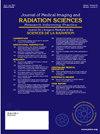减影碘绘图在肝脏肿瘤消融 CT 扫描中的应用 - 初步经验报告
IF 1.3
Q3 RADIOLOGY, NUCLEAR MEDICINE & MEDICAL IMAGING
Journal of Medical Imaging and Radiation Sciences
Pub Date : 2024-10-01
DOI:10.1016/j.jmir.2024.101476
引用次数: 0
摘要
方法SGH 混合血管造影 CT 系统(2021 年安装)由 Genesis 版 CT 系统和 Alphenix Sky+ 血管造影系统组成。CT 扫描仪每转一圈可扫描 640 张切片,最大扫描范围为 16 厘米。肝脏消融术后的碘绘图通常在消融术后对比增强 CT 上进行。这种减影技术是将两个扫描容积的图像相减,以突出显示肝实质中不同的造影剂摄取情况。我们计划通过一个小型回顾性病例系列展示碘图技术在肝脏肿瘤消融术中的应用。结果我们计划通过 5 个病例系列展示肝脏肿瘤消融术后减影 CT 成像中的碘图如何有助于发现任何未消融的残余肿瘤和出血(最可怕的急性并发症)。特别是,与传统的对比后 CT 图像重建相比,它是如何改进的。此外,我们还将介绍碘映射减影 CT 的成像误区,以防止误读。摘要我们在肝脏消融术后即时扫描中应用碘映射的初步经验表明,碘映射是解读肝脏消融术后 CT 的有效辅助手段,能更早期、更准确地发现残余肿瘤和并发症。本文章由计算机程序翻译,如有差异,请以英文原文为准。
Application of Subtraction Iodine Mapping in the Immediate Liver Tumour Ablation CT Scan – Initial Experience Report
Purpose
To share our initial experience and benefits of the iodine mapping application in the post-liver radiofrequency ablation CT scan compared to conventional post-contrast CT liver image reconstruction.
Methodology
The SGH hybrid angiography-CT System (installed 2021), comprises the Genesis edition CT system and Alphenix Sky+ angiography system. The CT scanner gives 640 slices per rotation, with a maximum of 16cm field coverage. Iodine mapping in the post-liver ablation is routinely performed on the post-ablation contrast-enhanced CT. This subtraction technique involves taking two scan volumes and subtracting the images to highlight the differential contrast uptake in the liver parenchyma. Color-coded maps of iodine distribution within the liver parenchyma are then generated to demonstrate enhancement and washout to facilitate interpretation.
We plan to showcase the application of the iodine map technique in liver tumor ablation to through a small retrospective case series.
Result
Through a series of 5 cases, we plan to demonstrate how iodine mapping from subtraction CT imaging after liver tumor ablation facilitates the detection of any non-ablated residual tumors and bleeding which is the most dreaded acute complication. In particular, how it is an improvement from conventional post-contrast CT image reconstructions. In addition, we will show pitfalls in imaging to prevent misinterpretation of iodine mapping subtraction CT.
Summary
Our initial experience in the application of iodine mapping for immediate post-liver ablation scans demonstrates that it is a useful adjunct for the interpretation of post-liver ablation CT to provide more early and accurate detection of residual tumors and complications.
求助全文
通过发布文献求助,成功后即可免费获取论文全文。
去求助
来源期刊

Journal of Medical Imaging and Radiation Sciences
RADIOLOGY, NUCLEAR MEDICINE & MEDICAL IMAGING-
CiteScore
2.30
自引率
11.10%
发文量
231
审稿时长
53 days
期刊介绍:
Journal of Medical Imaging and Radiation Sciences is the official peer-reviewed journal of the Canadian Association of Medical Radiation Technologists. This journal is published four times a year and is circulated to approximately 11,000 medical radiation technologists, libraries and radiology departments throughout Canada, the United States and overseas. The Journal publishes articles on recent research, new technology and techniques, professional practices, technologists viewpoints as well as relevant book reviews.
 求助内容:
求助内容: 应助结果提醒方式:
应助结果提醒方式:


